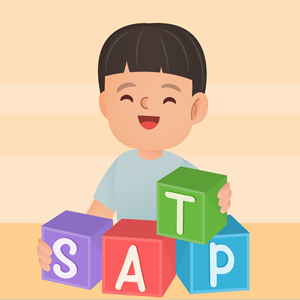Phase 2: Introducing the First Letters

Phase 2: Introducing the First Letters
When children have developed the basic physical and sensory skills of Phase One, they are ready to begin learning letters, which are called graphemes in a phonics programme and the sounds that those letters represent, which are called phonemes.
Beginning in reception year, the teacher gradually introduces letters one at a time in a systematic sequence, starting with the easiest letters first.
The children only learn the lower-case (small) letters and are not introduced to capital letters at this stage. Why is this? Well, we actually do not need capitals in order to read. If you look at this article, you will notice that capitals make up only a very small percentage of the text and, if they were removed, you could still understand most of it. So when the children only have to learn the small letters, they learn just what is necessary to help them successfully read words as quickly as possible.
Also, children do not learn the names of the alphabet letters. This will come later. Instead, they learn to connect the letters to the sounds they represent. When they are introduced to the letter 's', for example, they do not learn that it is called 'ess'. Instead, they connect the curved line they see directly with the hissing 'sss' sound that it represents. This is called a grapheme-phoneme correspondence or CPC.
The Department for Education Curriculum for England requires teachers to introduce 19 graphemes in the reception year. Children learn that the five vowels, a, e, i, o and u are each used to represent a single short sound: a as in cat, e as in ten, i as in sit, o as in dog and u as in mum. They also learn 14 consonants, each of which is linked to a single sound. Some of the consonants will be used to introduce pupils to simple digraphs (two letters written together to represent a single sound). They do not learn the soft g (as in giant) or the soft c (pronounced 's' as in celery), nor do they learn j, q, v, w, x, y, or z. They will learn these in Phase 3.
The 19 graphemes are divided into five sets. Children learn one set and practise reading words made with that set before proceeding to the next one. They also learn a small number of high frequency exception words. These do not follow regular spelling rules. More of these tricky words are introduced a few at a time in subsequent stages.
The graphemes are taught in the following sequence:
Set 1: s, a, t, p
These four letters can be used to make seven words: a, at, as, sat, pat, tap, and sap. Once the children know these four letters, they can begin learning to read words almost immediately by sounding out the letters of a word and then blending them together. If they look at the word sap, for example, they will first say the sounds 's' + 'a' + 'p' slowly and then gradually say the sounds quicker and quicker until they blend together to form the word 'sap'.
They also work on segmentation, meaning they practise recognising individual sounds in words that they hear.
Set 2: i, n, m, d
As each new grapheme is introduced, the children are able to read more words by blending and sounding out combinations made with both the letters they already know and the new ones. Once they know i they can sound out it, is, sit, pit, tip, pip, sit and sip. The addition of n, m and d enables them to read even more words.
Set 3: g, o, c, k
At this stage, each of the three consonants in this set is associated with one sound only. The letter g is introduced as the hard sound we hear at the end of words like pig and dig, and at the beginning of words like gag and gap. Children learn that the letters c and k both stand for the same hard 'k' sound, (the 'c' as in can and cat is the same sound as 'k' in kid and kit).
Set 4: ck, e, u, r
In addition to the final two vowels, this set introduces the 'r' sound used at the beginning of words like run and rat. It also introduces pupils to their first digraph, ck, which is another way to write the 'k' sound.
Pupils also learn two common exception words, they need to recognise by sight, because they contain graphemes they have not yet learnt. These are the which contains the digraph th and an 'uh' sound represented by the letter e, and to which uses the letter 'o' to represent the long vowel sound 'oo'.
Set 5: h, b, f, ff, l, ll, ss
With four single letters and three digraphs, this final set is the largest. The digraphs are easy to learn, however, because they simply double familiar letters at the end of words. So a single f is used at the beginning of words like fun while a double ff is used at the end of words like puff. Similarly, l begins words like leg and words like doll end in a double ll. The double ss is used at the end of words like kiss. In addition, three new exception words are introduced: no and go which use o to represent a long 'o' sound, and I which is read as a long 'i' sound.
By the end of Phase Two, the children have learnt the techniques of segmentation and sounding out and are ready to continue practising these skills and learn more graphemes in the next stage.
Continue reading: Phonics Phase 3: Expansion

